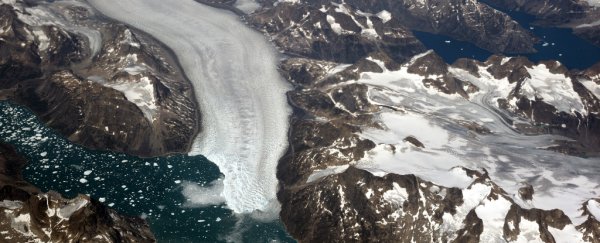Greenland's coastal glaciers and ice caps have passed a pivotal tipping point - a new study concludes that they've melted so much that they're now past the point of no return, and it's unlikely in current conditions that they'll be able to regrow the ice they've lost.
What's even scarier is that the researchers identified that this tipping point was reached two decades ago back in 1997 - and no one noticed until now.
While the overall news is pretty grim, in the short term, there's no need to panic. The study looked only at the comparatively small coastal glaciers and ice caps in Greenland, not the huge, inland 'Greenland Ice Sheet', which is the second largest ice cache in the world.
And even though these coastal glaciers have passed the point of no return, the researchers predict it's unlikely they'll melt entirely until 2100 - when that happens it's estimated that it will raise global sea levels by around 3.8 cm (1.5 inches).
That's enough to impact coastal regions and low-lying islands. But when you compare it to the 7.3 metres (24 feet) that global sea levels are predicted to rise if the entire Greenland Ice Sheet were to melt away all at once… well, it puts things into perspective.
"These peripheral glaciers and ice caps can be thought of as colonies of ice that are in rapid decline, many of which will likely disappear in the near future," said one of the researchers, geologist Ian Howat from Ohio State University.
"In that sense, you could say that they're 'doomed'. However, the ice sheet itself is still not 'doomed' in the same way. The vast interior ice sheet is more climatologically isolated than the surrounding glaciers and ice caps."
"Also, since this 'tipping point' was reached in the late '90s before warming really took off, it indicates that these peripheral glaciers are very sensitive and, potentially, ephemeral relative to the timescales of response of the ice sheet," he added.
The discovery is incredibly important, though, because it shows scientists exactly why the most vulnerable parts of Greenland's ice are melting so quickly - each summer since 1997, melting ice that would usually be captured and refrozen the next winter is now flowing straight out to sea.
Howat and his team were able to figure this out by creating high-resolution topographic models of the glaciers and their boundaries, as well as a numerical model of exactly how much water was flowing off these coastal glaciers and ice caps - technology that wasn't available back in 1996.
The team found that, for the last 20 years, the glacier and ice cap mass loss has been exactly equal to the amount of meltwater runoff lost to the sea.
They ran a number of simulations for what could cause this to happen, and came back with a pretty clear answer.
The study suggests that up until 1997, whenever the ice caps and glaciers melted, the runoff would be filtered through a layer of older snow called the 'firn' and trickle down to the ice surface, where it would freeze again, allowing the glaciers and ice caps to grow each winter.
But the firn around Greenland's coast became fully saturated 20 years ago, and froze through from bottom to top. Since 1997, there have been no gaps for the meltwater to filter through, meaning it runs off straight into the ocean, lost forever to the glacier.
As a result, the coastal ice caps and glaciers lose their melting ice as run off 65 percent faster than they can recapture it - contributing to a loss of ice equivalent to roughly 14 percent of the total mass of Greenland.
What's really important now is that the Greenland Ice Sheet is vulnerable to the same process, but to a lesser degree seeing as it's so big. Its firn still has plenty of capacity to recapture meltwater… for now, anyway.
But the new study provides "more evidence of rapid change and how it happens," said Howat. Which means researchers now know what to look for so that we don't also miss this vital ice sheet passing the point of no return.
There's no getting around the fact that the loss of the Greenland Ice Sheet and the resulting sea level rise would be pretty devastating for humanity.
Protecting it is even more important now that the West Antarctic ice sheet's collapse has already started. It's estimated that roughly 99 percent of Earth's land ice is stored in the ice sheets that cover Antarctica and Greenland, so their health is something scientists - and the world - can no longer ignore.
The research has been published in Nature Communications.
